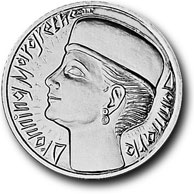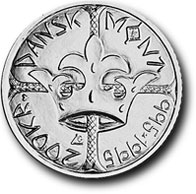|
The first Danish coins are believed to have been minted in Hedeby in Schleswig in the early 9th century. Some people believe that coins were minted in Ribe as early as the beginning of the 8th century, but this has not been proved yet.
The first coin bearing the name of a Danish king was minted by Svend Tveskæg (Sweyn Forkbeard) around the year 995 and shows the King's portrait, name and title. The coin was made of silver. For many centuries, Danish coinage was based on silver. The value of the coins was determined by their weight.
 
11th century: The first coinage
The first actual organised coinage was created by Knud den Store (Canute the Great) in the 1020s. Lund was the principal minting place and one of Denmark's most important cities in the Middle Ages, but coins were also minted in Roskilde, Slagelse, Odense, Aalborg, Århus, Viborg, Ribe, Ørbæk and Hedeby. For almost 1,000 years, Danish kings – with a few exceptions – have issued coins with their name, monogram and/or portrait. Coins were used not only as a means of payment, but also as the state's probably only form of mass communication by which the king could assert his sovereignty.
Debasement of coins
The coinage was based on silver, but to give the kings – and thus the state – an easy source of income, the metal value was gradually reduced, and thus did not correspond to face value. In addition, taxes were sometimes imposed via the coinage, e.g. in connection with compulsory substitutions where the value of the new coins received did not match that of the old coins handed in.
Introduction of the krone
In 1875, kroner and øre replaced rigsdaler and skilling. At the same time, the gold standard was introduced instead of the silver standard.The latter part of the 18th century and much of the 19th century saw expanding economic activity and thus also a need for means of payment that were easier to handle than coins. Consequently, banknotes were increasingly used instead of coins.
Seignorage
Historically, issuing money has been a royal prerogative, one of the reasons being that it generates considerable revenue. Today, substantial revenue can still be made from issuing banknotes and coins. This revenue, known as seignorage, accrues to Danmarks Nationalbank. Since Danmarks Nationalbank's profit after allocations to reserves is payable to the Treasury, the seignorage benefits society as a whole.
Copenhagen, Kongsberg and Altona
From 1771, coins were minted in Copenhagen, Kongsberg (Norway) and Altona (now a suburb of Hamburg in Germany). In 1814, Norway, and thus Kongsberg, was surrendered to Sweden, and in 1861 the last Altona coins were minted. Since 1864, The Royal Mint in Copenhagen has been the only mint in Denmark.
In 1841 it was decided that coins should bear a mint mark – showing where they had been minted – and the initials of the mint master and the medallist. The Mint in Altona chose an orb as its mint mark, while the Mint in Copenhagen opted for a heart, a private mint mark long used by the mint masters Christian Wineke, father and son. The heart was replaced by a crown in 1842, but when the krone was introduced in 1875, the original heart was re-introduced. The last Altona coins were minted in 1861, and since 1864 the only Danish mint has been the one in Copenhagen. Today the hearts on the coins are therefore a purely decorative feature.
Further information
The following books provide further information on the history of Danish coinage:
"Tusindtallets Danske Mønter fra Den Kgl. Mønt- og Medaillesamling/Danish coins from the 11th century in the Royal Collection of Coins and Medals" edited by Jørgen Steen Jensen. National Museum of Denmark 1995. ISBN 87-16-12011-6.
"Danmarks mønter og sedler – Krone og øre fra 1875 til i dag" (Denmark's coins and banknotes – Krone and øre from 1875 to the present – in Danish only) by Jørgen Steen Jensen. Aschehoug. 2001. ISBN 87-11-16248-1.
"The Coins and Banknotes of Denmark". Danmarks Nationalbank 2005. ISBN 87-87251-55-8. |